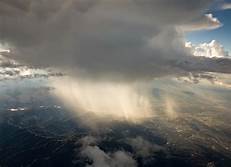What Is a Cloudburst?

“Highly-localised rains” in Amarnath, Jammu and Kashmir, caused flooding and led to the deaths of at least 16 people and injuries to more than 20 others.
- A cloudburst refers to an extreme amount of rain that happens in a short period, sometimes accompanied by hail and thunder, and this has a precise definition.
- The India Meteorological Department (IMD) defines it as unexpected precipitation exceeding 100mm (or 10 cm) per hour over a geographical region of approximately 20 to 30 square km
- They are more likely to occur in mountainous zones mainly because of terrain and elevation.
- A cloudburst occurs when moisture-carrying air moves up a hilly terrain, forming a vertical column of clouds known as ‘cumulonimbus’ clouds.
- Such clouds usually cause rain, thunder and lightning. This upward motion of the clouds is known as an ‘orographic lift’.
- These unstable clouds cause an intense rainstorm over a small area after becoming heavy enough and locked in the ridges and valleys between the hills.
- The energy necessary for the cloudburst comes from the upward motion of air. Cloudbursts mostly occur at elevations between 1,000-2,500 metres above sea level.




